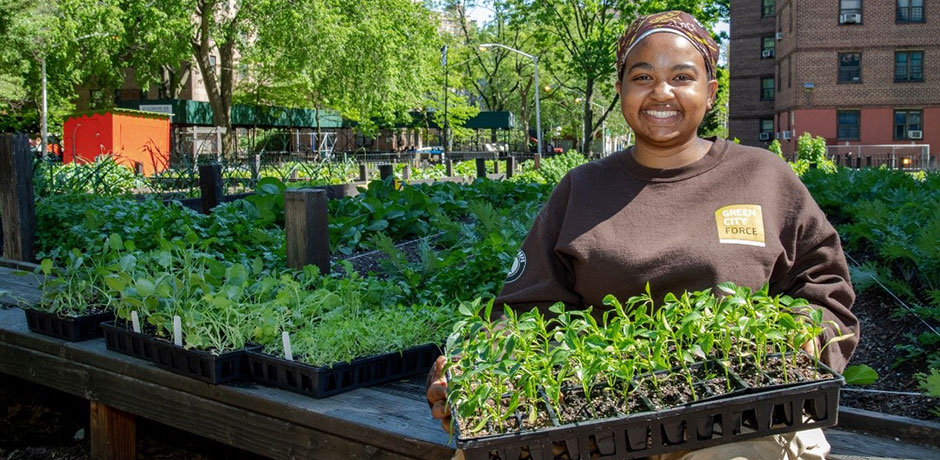City Blooming for Beginners
City Blooming for Beginners
Blog Article
An Unbiased View of City Blooming
Table of ContentsA Biased View of City BloomingThe Best Guide To City BloomingThe 7-Second Trick For City BloomingExamine This Report about City BloomingThe Best Guide To City Blooming

As you stroll the roads of the Bronx, Southside Chicago or East Oakland, you may see have actually also seen big plots of ripening fruits and vegetables being collected. What specifically are urban ranches and area gardens? Urban agriculture, urban farming, or city horticulture is the practice of growing, processing and distributing food in or around metropolitan locations.
Generally, city farming as a practice is a larger financial investment than horticulture. There are numerous more hours spent into the minutiae of farming, from the crop strategy to the tending of your beds. This moment commitment handles an entire new definition once you realize the objective that is being worked towards and committed, specifically that of acquiring a plentiful return of plants to be consumed.
An area yard is a solitary tract gardened jointly by a team of individuals. Neighborhood gardens use either specific or common stories on personal or public land while creating fruit, vegetables, and/or plants expanded for their eye-catching look. The fundamental version here is that a large team of people each add a reasonably percentage of time to working their very own story, and receive the fruits of their labor consequently.
7 Simple Techniques For City Blooming

There are area yards, several of whom Tiny Axe Peppers has actually partnered with, that offer assistance to evacuees, low-income family members, youngsters groups, and neighborhood companies by assisting them create and expand their very own yards. The distinctions between community yard and metropolitan ranch are nuanced, though in the end the exact same standard task takes placefood crop growing however within various business frameworks.
Urban ranches are typically much more business and technology oriented, with the main function of making best use of returns and selling produce. Industrial metropolitan farms are frequently targeted at increasing manufacturing on generally little land location with technologies in innovations such as aquaculture, hydroponics, and greenhouses and may companion with a commercial kitchen to develop locally-produced value-added items such as jams and sauces.
The Facts About City Blooming Uncovered
The produce is typically expanded on a much smaller range and is taken home to consume at home or to share. By providing much required eco-friendly areas in penniless, concrete city locations, they enable the advantages of backyard horticulture to those lacking yards, and function as exceptional instances of self-organization and area activism.
Some neighborhood yards, commonly in metropolitan areas, relocate into growing for commercial usage while some city ranches open up their land for even more socially aware benefits. Regardless of exactly how you specify and separate the 2, they are both positive pressures for good in cities around America and the globe.
As every one of Tiny Axe Peppers' hot sauces are sourced with peppers from community yards, your purchases directly aid fund these local tasks (https://hearthis.at/cityblooming/set/city-blooming/). So, participate in the transformation by.
A buddy of mine just recently commented in a discussion about gardening that "It's intriguing, I've always thought that farming as a practice is somewhat like horticulture. There are comparable elements he has a good point to both do not you believe?" To the layperson that comment from my good friend would certainly have gone without much thought, it appears practical so why not take it? Yet as I spent more and more time in my Urban Farming class I have actually concerned recognize that to claim that horticulture is a tiny extension of agriculture would certainly be a little bit of stretch.
The Single Strategy To Use For City Blooming
They both focus on the care of plants for some objective that can be food, earnings or just the enjoyment of the craft. Furthermore they both call for a monetary investment on top of a time investment, something that a whole lot of people in our rapid paced life do not have a great deal of - balcony and patio garden design.
We can see that the resemblances are plentiful, yet are the distinctions enough to create a distinction? As a pupil at NYU I have the opportunity to deal with the leave It Much better Foundation, a team that shows fundamental nutrition and horticulture to secondary school students. https://www.slideshare.net/danielnold94107. This experience provided me an extensive foray right into the world of amateur gardening beyond what the majority of people have been in contact with
Farming as a method is a bigger financial investment than horticulture. There are many a lot more hours invested right into the minutiae of farming, from the plant plan to the tending of your beds.
The typical garden enthusiast sets about his duties as a chore instead of a need and thus identifies his or herself from the farmer. Nevertheless with this difference in hand, they are both relaxing and soothing exercises that anyone can grab, which by itself ought to be a promotion for both.
9 Simple Techniques For City Blooming
Something failed - eco-friendly practices. Wait a minute and try once more Try once again
Report this page